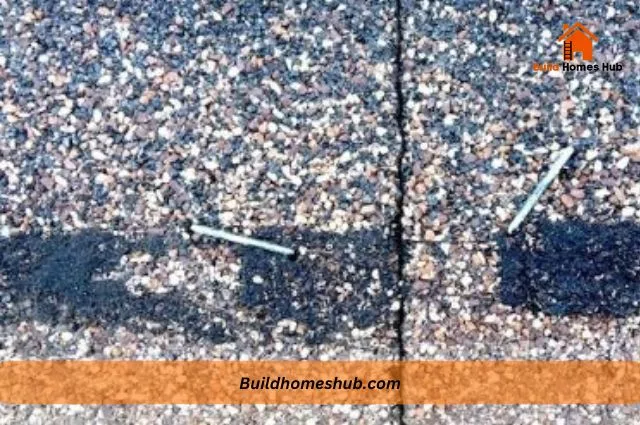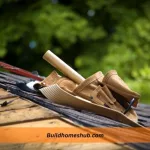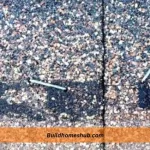When it comes to construction, many of us are familiar with using staples. They are an easy and efficient way to fasten materials together, but have you ever wondered if they are legal to use in certain situations?
This article will explore the legality of using staples in construction and where their use is restricted or prohibited. From roofing to electrical work, we’ll look closely at the guidelines and regulations surrounding using staples in various industries.
Are Roofing Staples Illegal?
No, roofing staples are not illegal in the United States. They are a commonly used fastener for attaching roofing underlayment, felt paper, and other materials to the roof deck. However, the use of roofing staples may be regulated by local building codes or industry standards in some areas. For example, some codes may require using certain staples or specify the minimum distance between staples.
It is important to check with your local building department or a professional contractor to determine the requirements for using roofing staples in your area.
In Which Instances Are Roofing Staples Not Allowed?
There are several instances in which the use of roofing staples may not be allowed or may not be suitable. These include:
1. If they do not meet the required specifications
Some building codes or industry standards may specify the type or size of roofing staples that must be used to ensure the stability and integrity of the roofing system. If staples do not meet these specifications, they may not be allowed.
2. If they are not installed correctly
Proper installation of roofing staples is important to ensure the stability and integrity of the roofing system. If staples are not installed correctly, they may not provide sufficient support and could potentially cause problems with the roofing system.
3. If they are not suitable for the material being installed
Different materials may require different types of fasteners. For example, some materials may be too heavy or too thin for staples or require a different type of fastener for proper installation.
It is important to check with your local building department or a professional contractor to determine the requirements for using roofing staples in your area and to ensure that they are being used correctly and appropriately for the materials being installed.
What Kind of Roofs Can You Use Staples for?
Roofing staples are commonly used to attach roofing underlayment, felt paper, and other materials to the roof deck of most types of roofs. This includes roofs made of asphalt shingles, wood shingles or shakes, metal, clay, or concrete tiles and other materials.
However, it is important to follow the manufacturer’s recommendations and any local building code requirements for the use of roofing staples on a specific roofing material. Some materials may require the use of a different type of fastener or may not be suitable for staples at all. For example, some roofing materials may be too heavy or brittle to be fastened with staples. In these cases, it may be necessary to use nails or another type of fastener.
It is also important to consider the slope and structure of the roof when choosing a fastener. Staples may not be suitable for roofs with a very steep slope or roofs with certain types of trusses or other structural elements. In these cases, it may be necessary to use a different type of fastener or to consult with a professional contractor to determine the most appropriate fastening method.
Types of Staples for Roofing
Several types of roofing staples are commonly used for attaching roofing underlayment, felt paper, and other materials to the roof deck. Some of the most common types of roofing staples include:
1. Galvanized steel staples
These staples are made of galvanized steel, which makes them resistant to corrosion and rust. They are often used for attaching roofing felt and other materials to the roof deck.
2. Stainless steel staples
Like galvanized steel staples, stainless steel staples are resistant to corrosion and rust. They are often used in marine or coastal environments where there is a higher risk of corrosion.
3. Plastic staples
Plastic staples are a lightweight and cost-effective alternative to metal staples. They are often used for attaching lightweight materials, such as vapor barriers, to the roof deck.
4. Nail-in staple
These staples are similar to regular staples, but they have a small nail on the end to help them hold better in wood or other soft materials. They are often used to attach roofing felt or other materials to wooden roofs or roofs with plywood decks.
5. Adhesive staples
These staples are coated with a strong adhesive that helps them hold in place without needing nails or other fasteners. They are often used for attaching lightweight materials, such as vapor barriers, to the roof deck.
Advantages of Using Staples for Roof
There are both advantages and disadvantages to using staples for roofing projects. Some of the potential pros of using staples include:
1. They are relatively cheap and easy to find
Staples are widely available and generally cost less than other types of fasteners, such as nails or screws. This can make them an appealing choice for budget-conscious homeowners or contractors.
2. They are easy to install
Staples can be installed quickly and easily using a staple gun or hammer. This can save time and labor costs during a roofing project.
3. They may be suitable for certain materials
Staples may be suitable for attaching certain lightweight or thin materials, such as vapor barriers or roofing underlayment, to the roof deck.
Disadvantages of using staples for roofing projects
1. They may not provide as much holding power as other fasteners
Staples may not hold as securely as nails or screws, especially in high winds or other adverse weather conditions. This could potentially lead to problems with the roofing system, such as leaks or damage.
2. They may not be suitable for all roofing materials
Staples may not be suitable for attaching certain types of roofing materials, such as slate or certain types of clay tiles, which may be too heavy or brittle to be fastened with staples.
3. They may not be allowed by local building codes
Some local building codes or industry standards may prohibit the use of staples or require the use of a different type of fastener for certain roofing materials or conditions. Check with your local building department or a professional contractor to determine the requirements for using staples in your area.
Alternative Fastening Methods for Roofing Instead of Staples
1. Using a nail gun
A nail gun is a powerful tool that drives nails into the material you’re fastening. It works like a hammer, but instead of striking the nail with your hand, you hold down the trigger and press it against a piece of wood or metal until it drives through.
A nail gun operates on air pressure (as opposed to electric motors), which means that it can drive nails through materials that would be too thick for a drill or screwdriver. The nail will remain firmly in place afterward because of its pointed end and because no glue is required to hold it there; this makes roofing fasteners ideal candidates for this method.
The best part about using a nail gun is its versatility. You can use them with many different types of materials, aluminum siding and shingles are two popular choices. And they come in different sizes depending on how strong you need them to be.
2. Using ring shank nails
Ring shank nails are the strongest fasteners for attaching roofing materials to your home’s rafters. Ring shank nails are likely your best bet if you’re installing a new roof or replacing an old one.
If you choose ring shank nails, make sure they are galvanized or stainless steel and that they have thick heads (no less than 1/4 inch). They should also have a ring around each end of their shanks (whereas some other types of nails only have rings on one end).
As for how many you’ll need? Generally speaking, about 1000 pounds per square foot of roofing material is considered sufficient; however, this number increases depending on what kind of material you choose and its thickness as well as how close together those pieces are spaced out over the surface area in question.
3. Using screws specifically for roofing
The first step to installing your new roofing system is to prepare the deck. This is where you will install your fasteners and secure the sheets of material to the structure of your house. The easiest way to do this is by using screws specifically meant for use on roofs.
These screws have a self-tapping point that allows them to penetrate through the shingle and into the roof deck without requiring additional tools or equipment other than a power drill. You can also choose from different lengths, so ensure that you get one long enough to go through both layers of material and solid wood if there’s no plywood underneath it.
Can You Staple Down Roofing Felt?
According to best practices, staples are commonly used to attach roofing felt to the roof deck. Roofing felt, also known as tar paper or underlayment, is a material installed under the roofing shingles or tiles to provide an additional layer of protection against water infiltration.
Staples are often used to fasten the felt to the roof deck, although other fasteners, such as nails or adhesive, may also be used. The staples should be long enough to penetrate through the felt and into the roof deck, but not so long as they protrude through the other side.
It is important to follow the manufacturer’s recommendations for the spacing and placement of the staples, as well as any local building code requirements. Proper installation of the roofing felt and staples can help ensure the integrity and longevity of the roofing system.
FAQ
Can You Use Staples on Shingles?
It is not recommended to use staples on shingles as they can damage the shingles and weaken the roof’s overall integrity. Instead, roofing nails or adhesive is recommended to secure the shingles. This ensures a secure and long-lasting hold that will not damage the shingles or compromise the overall stability of the roof.
Conclusion
In summary, roofing staples are widely used fasteners in the roofing industry. While they are not illegal in the United States, it is important to check with your local building department or a professional contractor to determine any regulations or requirements that may be in place for their use. Proper installation and use of roofing staples can help ensure the integrity and longevity of a roofing system.
I like to think I can help you with all the information you need on home renovations and DIY tips. You should subscribe.











